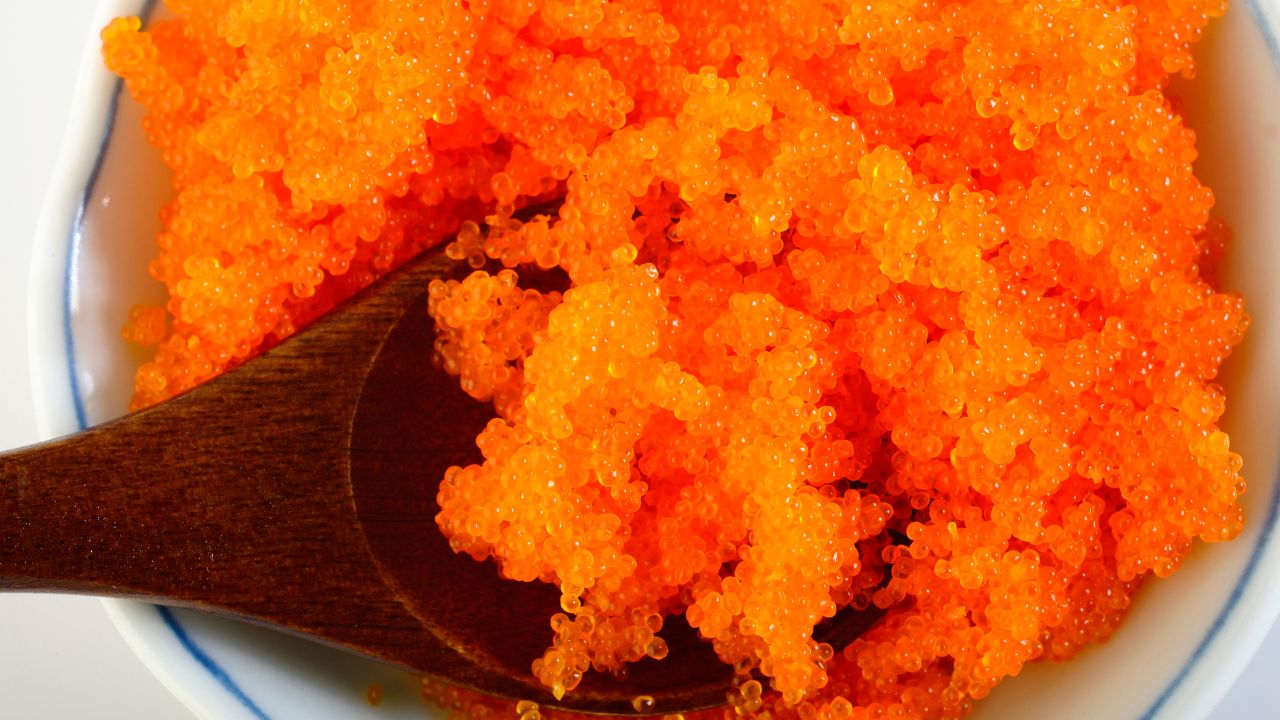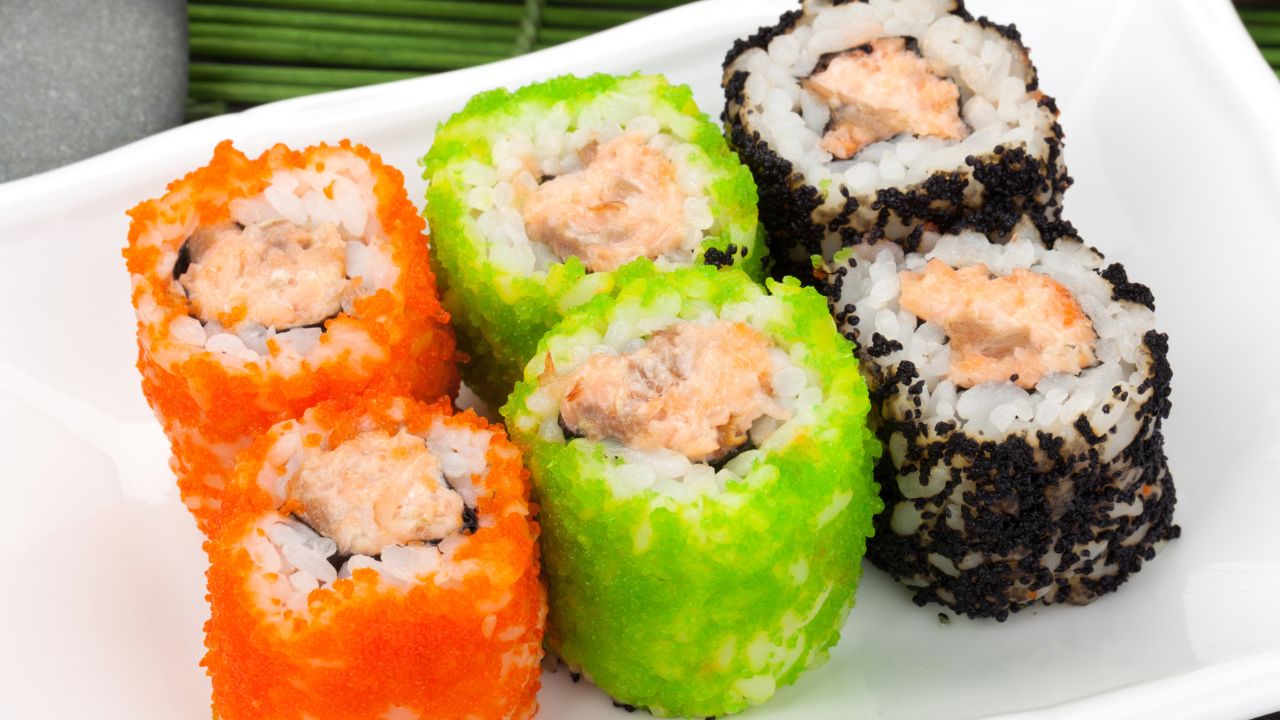If you’ve ever ordered sushi from a classy restaurant or even made one yourself at home following a step-by-step guide, you may not have realized that there’s a high chance you have already tried the incredible flavor of tobiko.
These natural ingredients are so small that they can often go under the radar when compared to their sushi counterparts, however they are actually packed with a tremendous amount of flavor that helps to give a meal a much more prominent and memorable taste which you are sure to recognize once you know exactly how it tastes.

That is what we are going to be looking at below to explain the overall taste of tobiko along with the most popular ways to prepare and eat this delightful ingredient.
What Is Tobiko Used For?
Tobiko is a very popular ingredient in many Japanese meals that is immediately recognizable for its bright orange appearance.
They are very similar to other kinds of Japanese caviar (see also ‘What Is Narutomaki And How Does It Taste?‘) which can commonly lead to a lot of confusion, however, one area where it does differ from other types of caviar is in its variety, and specifically just how many recipes you can incorporate it into.
While it is very commonly used as a topping as part of a sushi dish, tobiko is also mixed in as part of a tasty and nutritious salad in many cases to add a little more of that loveable seafood flavor.
It can also just as easily be sprinkled over a fish-based meal such as a salmon tobiko bowl to enhance the fishy flavors even more while adding a slightly more crunchy texture which you will notice immediately once you take a few bites.
You can even use tobiko to mix up the flavor in some more casual meals and snacks such as an omelet where the tobiko actually mixes incredibly well with the egg and butter to create a creamy texture that’s a pure delight to bite into.
How Does Tobiko Taste?
If you have ever tried ikura or red caviar before, tobiko tastes extremely similar to that specifically because it contains the perfect blend of being both salty and smokey without one flavor overtaking the other.
While the taste is very prominent and can be noticed as soon as you bite into one of these delicious small appetizers, they are still considered to be fairly mild in flavor which is why they are usually enjoyed along with other types of food rather than eaten on their own.
While it does have a very noticeable salty taste with a hint of underlying smokiness, if you’ve ever tried other similar types of roe such as caviar and ikura, you will notice that tobiko is still a little sweeter in its flavor which is part of the reason many people prefer it to its counterparts when looking to experience as much flavor as possible for the next meal.
If you’re worried about whether tobiko might be a little too chewy and annoying to eat because of their shape and texture, the good news is that while they have a crunchy texture that pops once you bite into them, they are still incredibly light and soft rather than being heavier and harder to chew apart.
Many people will also use tobiko to create tobiko sauce which is commonly used in rice dishes since it helps keep the rice from becoming dry and gives it an incredibly unique salty flavor with just a little bit of smokiness.
Tobiko sauce has an extremely creamy texture that is only mildly thick and still retains that familiar sweet, salty and smokey taste that tobiko is so well admired for.
Of course, you can also add any extra ingredients if you want to add any additional flavors into the mix, for example you can use a little bit of mustard to give the sauce an even richer taste with a hint of a citrus flavor shining through.
Different Colors Of Tobiko

While tobiko naturally takes on a reddish-orange color, some sushi chefs will often bathe the fish eggs in natural food colorings to change the shade of the color to mix their dish.
The most common natural ingredient used is wasabi which gives the tobiko a much deeper dark green appearance.
Squid ink is also commonly used to give the tobiko a very classy and stylish dark black appearance which looks much closer to caviar.
For spicier recipes, chili peppers can also often be used to allow the tobiko to stand out far more giving it a striking red color.
Ways To Serve Tobiko
There are a number of popular and delicious Japanese dishes that incorporate tobiko as part of their recipe to allow the naturally smoky and salty taste to enhance the other flavors and make for an incredible meal or appetizer that can really be enjoyed for any occasion.
Here are some of the most popular and delicious dishes that use tobiko:
Sushi Rolls
– Definitely, the most popular way to use tobiko is to use it as a garnish over some sushi, however it can just as easily be used to enhance the natural flavors of rice while also adding crunchier texture to the dish overall.
Gunkan Maki
– Tobiko can either be used on its own inside of a gunkan maki, or it can be wrapped inside the nori with some cucumber to make it even crunchier.
Gunkan makis are made from oval balls of rice which are wrapped in dried edible seaweed known as nori (see also ‘What Are Sea Grapes And How Do They Taste?‘).
Tobiko Nigri
– When tobiko is spread over nigri, which is a type of sushi that features a small mound of vinegared sushi rice topped with raw fish, it creates a dish that is both bursting with a delicious seafood flavor, while also having the perfect blend of being a little crunchy but also slightly soft to bite into.
Tobiko Appetizer
– While you can definitely use it to enhance a bigger meal or a snack that might take a little more preparation than usual, tobiko can just as easily be used for many everyday appetizers to make them even more delicious.
Omelets are one option, however you can even sprinkle some tobiko over some toast or plain crackers for an incredibly easy recipe that is still more than satisfying the bite into.
Summary
Tobiko is an incredibly underrated type of roe which is incredibly easy to add to essentially any dish yet adds so much more flavor that it’s always worth at least experimenting with, whether it’s as part of a bigger sushi-based meal, or even to make our favorite everyday appetizers even more delightful.
- 15 Traditional Greek Breads - July 31, 2023
- 30 Delicious And Gluten-Free Cookie Recipes - July 29, 2023
- 30 Of The Best European Desserts - July 29, 2023
